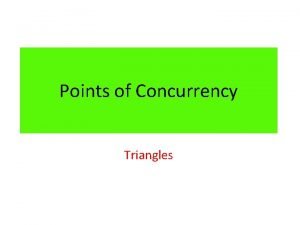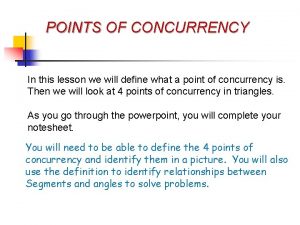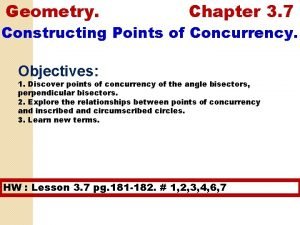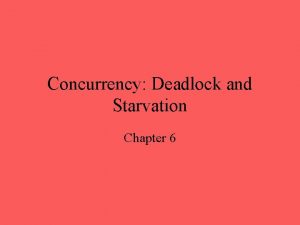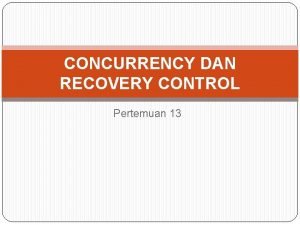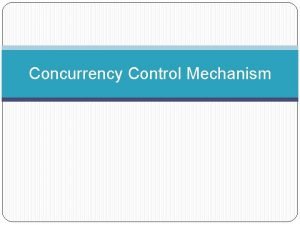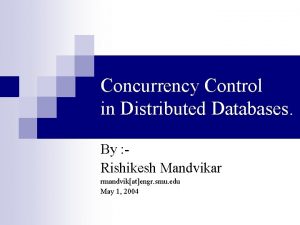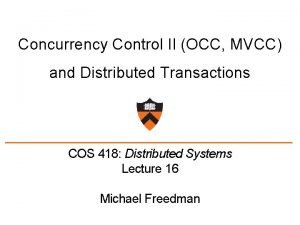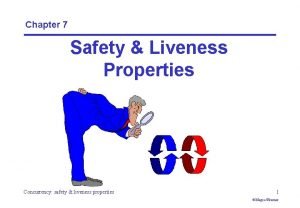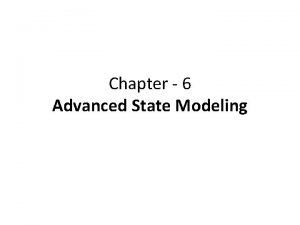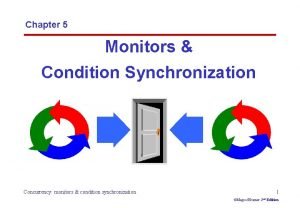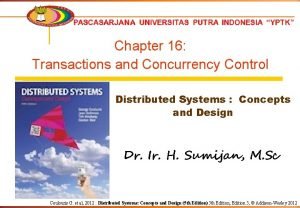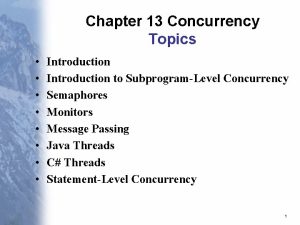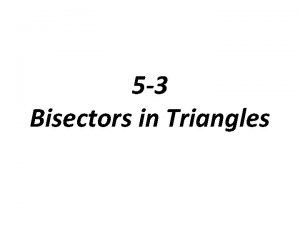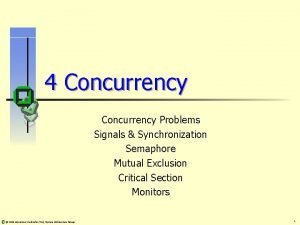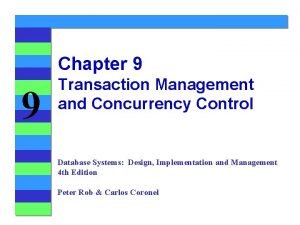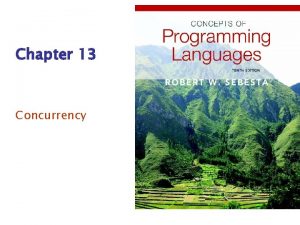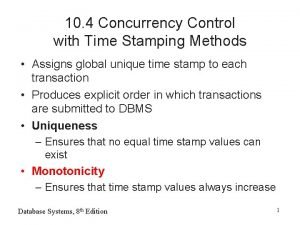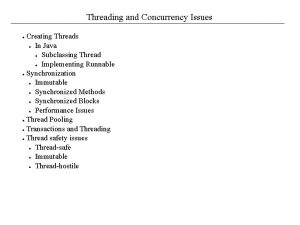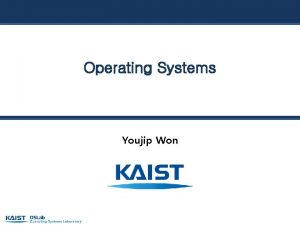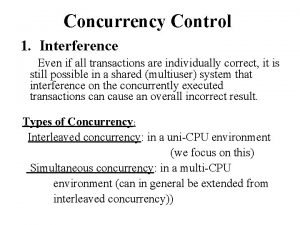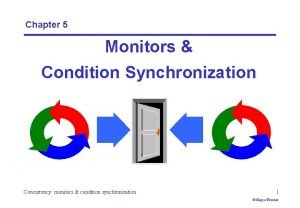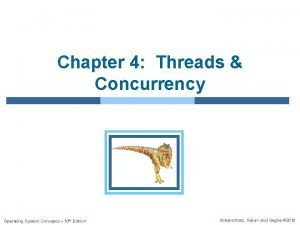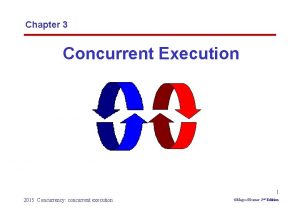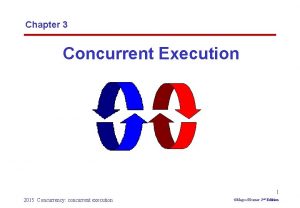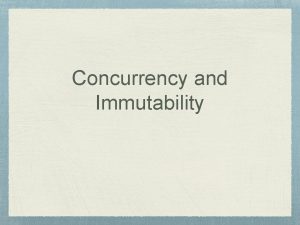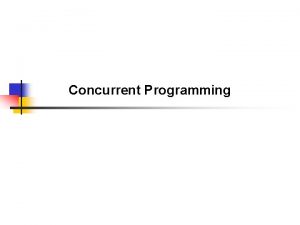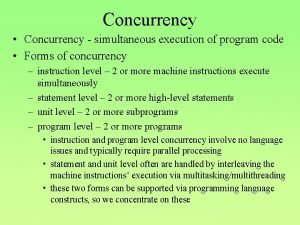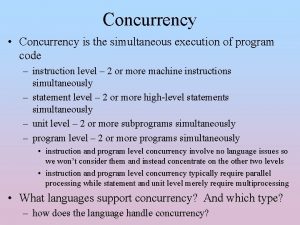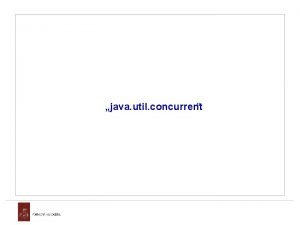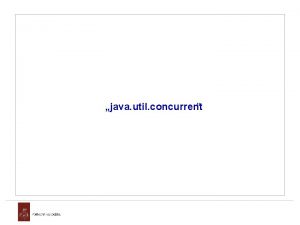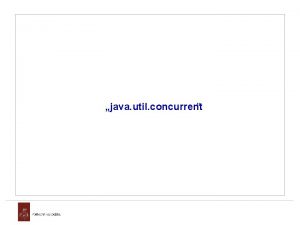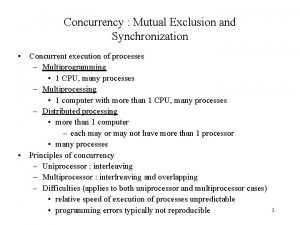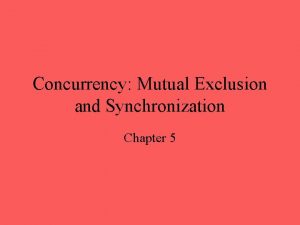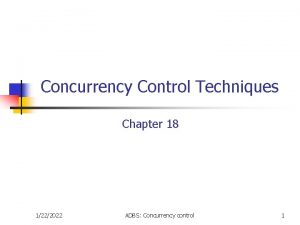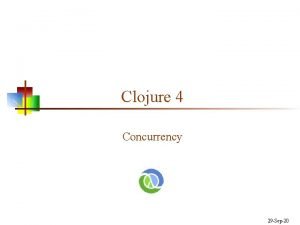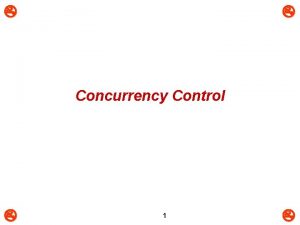Chapter 3 Concurrent Execution Concurrency concurrent execution 1






























- Slides: 30

Chapter 3 Concurrent Execution Concurrency: concurrent execution 1 ©Magee/Kramer

Concurrent execution Concepts: processes - concurrent execution and interleaving. process interaction. Models: parallel composition of asynchronous processes - interleaving interaction - shared actions process labeling, and action relabeling and hiding structure diagrams Practice: Multithreaded Java programs Concurrency: concurrent execution 2 ©Magee/Kramer

Definitions u Concurrency l Logically simultaneous processing. A Does not imply multiple processing B elements (PEs). Requires interleaved execution on a single PE. C u Parallelism l Physically simultaneous processing. Involves multiple PEs and/or independent device operations. Time Both concurrency and parallelism require controlled access to shared resources. We use the terms parallel and concurrent interchangeably and generally do not distinguish between real and pseudo-parallel execution. Concurrency: concurrent execution 3 ©Magee/Kramer

3. 1 Modeling Concurrency u How should we model process execution speed? l arbitrary speed (we abstract away time) u How do we model concurrency? l arbitrary relative order of actions from different processes (interleaving but preservation of each process order ) u What is the result? l provides a general model independent of scheduling (asynchronous model of execution) Concurrency: concurrent execution 4 ©Magee/Kramer

parallel composition - action interleaving If P and Q are processes then (P||Q) represents the concurrent execution of P and Q. The operator || is the parallel composition operator. ITCH = (scratch->STOP). CONVERSE = (think->talk->STOP). ||CONVERSE_ITCH = (ITCH || CONVERSE). think talk scratch think scratch talk scratch think talk Concurrency: concurrent execution Possible traces as a result of action interleaving. 5 ©Magee/Kramer

parallel composition - action interleaving 2 states (0, 0) from ITCH 3 states (0, 1) Concurrency: concurrent execution (0, 2) (1, 2) from CONVERSE (1, 1) (1, 0) 2 x 3 states 6 ©Magee/Kramer

parallel composition - algebraic laws Commutative: Associative: (P||Q) = (Q||P) (P||(Q||R)) = ((P||Q)||R) = (P||Q||R). Clock radio example: CLOCK = (tick->CLOCK). RADIO = (on->off->RADIO). ||CLOCK_RADIO = (CLOCK || RADIO). LTS? Concurrency: concurrent execution Traces? Number of states? 7 ©Magee/Kramer

modeling interaction - shared actions If processes in a composition have actions in common, these actions are said to be shared. Shared actions are the way that process interaction is modeled. While unshared actions may be arbitrarily interleaved, a shared action must be executed at the same time by all processes that participate in the shared action. MAKER = (make->ready->MAKER). USER = (ready->use->USER). ||MAKER_USER = (MAKER || USER). LTS? Traces? Concurrency: concurrent execution MAKER synchronizes with USER when ready. Number of states? 8 ©Magee/Kramer

modeling interaction - handshake A handshake is an action acknowledged by another: MAKERv 2 = (make->ready->used->MAKERv 2). USERv 2 = (ready->used ->USERv 2). 3 states ||MAKER_USERv 2 = (MAKERv 2 || USERv 2). 3 x 3 states? 4 states Interaction constrains the overall behaviour. Concurrency: concurrent execution 9 ©Magee/Kramer

modeling interaction - multiple processes Multi-party synchronization: MAKE_A = (make. A->ready->used->MAKE_A). MAKE_B = (make. B->ready->used->MAKE_B). ASSEMBLE = (ready->assemble->used->ASSEMBLE). ||FACTORY = (MAKE_A || MAKE_B || ASSEMBLE). Concurrency: concurrent execution 10 ©Magee/Kramer

composite processes A composite process is a parallel composition of primitive processes. These composite processes can be used in the definition of further compositions. ||MAKERS = (MAKE_A || MAKE_B). ||FACTORY = (MAKERS || ASSEMBLE). Substituting the definition for MAKERS in FACTORY and applying the commutative and associative laws for parallel composition results in the original definition for FACTORY in terms of primitive processes. ||FACTORY = (MAKE_A || MAKE_B || ASSEMBLE). Concurrency: concurrent execution 11 ©Magee/Kramer

process labeling a: P prefixes each action label in the alphabet of P with a. Two instances of a switch process: SWITCH = (on->off->SWITCH). ||TWO_SWITCH = (a: SWITCH || b: SWITCH). An array of instances of the switch process: ||SWITCHES(N=3) = (forall[i: 1. . N] s[i]: SWITCH). ||SWITCHES(N=3) = (s[i: 1. . N]: SWITCH). Concurrency: concurrent execution 12 ©Magee/Kramer

process labeling by a set of prefix labels {a 1, . . , ax}: : P replaces every action label n in the alphabet of P with the labels a 1. n, …, ax. n. Further, every transition (n->X) in the definition of P is replaced with the transitions ({a 1. n, …, ax. n} ->X). Process prefixing is useful for modeling shared resources: RESOURCE = (acquire->release->RESOURCE). USER = (acquire->use->release->USER). ||RESOURCE_SHARE = (a: USER || b: USER || {a, b}: : RESOURCE). Concurrency: concurrent execution 13 ©Magee/Kramer

process prefix labels for shared resources How does the model ensure that the user that acquires the resource is the one to release it? Concurrency: concurrent execution 14 ©Magee/Kramer

action relabeling Relabeling functions are applied to processes to change the names of action labels. The general form of the relabeling function is: /{newlabel_1/oldlabel_1, … newlabel_n/oldlabel_n}. Relabeling to ensure that composed processes synchronize on particular actions. CLIENT = (call->wait->continue->CLIENT). SERVER = (request->service->reply->SERVER). Concurrency: concurrent execution 15 ©Magee/Kramer

action relabeling ||CLIENT_SERVER = (CLIENT || SERVER) /{call/request, reply/wait}. Concurrency: concurrent execution 16 ©Magee/Kramer

action relabeling - prefix labels An alternative formulation of the client server system is described below using qualified or prefixed labels: SERVERv 2 = (accept. request ->service->accept. reply->SERVERv 2). CLIENTv 2 = (call. request ->call. reply->continue->CLIENTv 2). ||CLIENT_SERVERv 2 = (CLIENTv 2 || SERVERv 2) /{call/accept}. Concurrency: concurrent execution 17 ©Magee/Kramer

action hiding - abstraction to reduce complexity When applied to a process P, the hiding operator {a 1. . ax} removes the action names a 1. . ax from the alphabet of P and makes these concealed actions "silent". These silent actions are labeled tau. Silent actions in different processes are not shared. Sometimes it is more convenient to specify the set of labels to be exposed. . When applied to a process P, the interface operator @{a 1. . ax} hides all actions in the alphabet of P not labeled in the set a 1. . ax. Concurrency: concurrent execution 18 ©Magee/Kramer

action hiding The following definitions are equivalent: USER = (acquire->use->release->USER) {use}. USER = (acquire->use->release->USER) @{acquire, release}. Minimization removes hidden tau actions to produce an LTS with equivalent observable behavior. Concurrency: concurrent execution 19 ©Magee/Kramer

structure diagrams P a Process P with alphabet {a, b}. b P a c x m c x b d x Parallel Composition (P||Q) / {m/a, m/b, c/d} Q S x P a Concurrency: concurrent execution Q y Composite process ||S = (P||Q) @ {x, y} 20 ©Magee/Kramer

structure diagrams We use structure diagrams to capture the structure of a model expressed by the static combinators: parallel composition, relabeling and hiding. TWOBUFF in a: BUFF in out a. out b: BUFF in out range T = 0. . 3 BUFF = (in[i: T]->out[i]->BUFF). ||TWOBUF = ? Concurrency: concurrent execution 21 ©Magee/Kramer

structure diagrams Structure diagram for CLIENT_SERVER ? CLIENT call continue wait call reply request reply SERVER service Structure diagram for CLIENT_SERVERv 2 ? CLIENTv 2 continue Concurrency: concurrent execution call accept SERVERv 2 service 22 ©Magee/Kramer

structure diagrams - resource sharing a: USER PRINTER_SHARE printer: RESOURCE b: USER acquire release printer RESOURCE = (acquire->release->RESOURCE). USER = (printer. acquire->use ->printer. release->USER). ||PRINTER_SHARE = (a: USER||b: USER||{a, b}: : printer: RESOURCE). Concurrency: concurrent execution 23 ©Magee/Kramer

3. 2 Multi-threaded Programs in Java Concurrency in Java occurs when more than one thread is alive. Thread. Demo has two threads which rotate displays. Concurrency: concurrent execution 24 ©Magee/Kramer

Thread. Demo model ROTATOR = PAUSED, PAUSED = (run->RUN | pause->PAUSED |interrupt->STOP), RUN = (pause->PAUSED |{run, rotate}->RUN |interrupt->STOP). ||THREAD_DEMO = (a: ROTATOR || b: ROTATOR) /{stop/{a, b}. interrupt}. Concurrency: concurrent execution Interpret run, pause, interrupt as inputs, rotate as an output. 25 ©Magee/Kramer

Thread. Demo implementation in Java - class diagram Thread. Demo creates two Thread. Panel displays when initialized. Thread. Panel manages the display and control buttons, and delegates calls to rotate() to Display. Thread. Rotator implements the runnable interface. Concurrency: concurrent execution 26 ©Magee/Kramer

Rotator class Rotator implements Runnable { public void run() { try { while(true) Thread. Panel. rotate(); } catch(Interrupted. Exception e) {} } } Rotator implements the runnable interface, calling Thread. Panel. rotate() to move the display. run()finishes if an exception is raised by Thread. interrupt(). Concurrency: concurrent execution 27 ©Magee/Kramer

Thread. Panel class public class Thread. Panel extends Panel { Thread. Panel manages the display and control buttons for a thread. // construct display with title and segment color c public Thread. Panel(String title, Color c) {…} // rotate display of currently running thread 6 degrees // return value not used in this example public static boolean rotate() throws Interrupted. Exception {…} Calls to rotate() are delegated to Display. Thread. // create a new thread with target r and start it running public void start(Runnable r) { thread = new Display. Thread(canvas, r, …); thread. start(); Threads are created by } the start() method, and terminated by the // stop the thread using Thread. interrupt() public void stop() {thread. interrupt(); } stop() method. } Concurrency: concurrent execution 28 ©Magee/Kramer

Thread. Demo class public class Thread. Demo extends Applet { Thread. Panel A; Thread. Panel B; public void init() { A = new Thread. Panel("Thread A", Color. blue); B = new Thread. Panel("Thread B", Color. blue); add(A); add(B); Thread. Demo creates two } Thread. Panel displays public void start() { when initialized and two A. start(new Rotator()); threads when started. B. start(new Rotator()); } public void stop() { A. stop(); B. stop(); } Concurrency: concurrent execution } Thread. Panel is used extensively in later demonstration programs. 29 ©Magee/Kramer

Summary u Concepts l concurrent processes and process interaction u Models l Asynchronous (arbitrary speed) & interleaving (arbitrary order). l Parallel composition as a finite state process with action interleaving. l Process interaction by shared actions. l Process labeling and action relabeling and hiding. l Structure diagrams u Practice l Multiple threads in Java. Concurrency: concurrent execution 30 ©Magee/Kramer
 The place where all three altitudes meet is called the
The place where all three altitudes meet is called the Orthocenter practice problems
Orthocenter practice problems Concurrency in web applications
Concurrency in web applications Circumcenter conjecture
Circumcenter conjecture Concurrency control and recovery in database systems
Concurrency control and recovery in database systems Fplatform
Fplatform Unix concurrency mechanisms
Unix concurrency mechanisms Concurrency control and recovery
Concurrency control and recovery Pitfalls of lock based protocol
Pitfalls of lock based protocol Concurrency control in distributed databases
Concurrency control in distributed databases Timemasters locks
Timemasters locks Ada concurrency
Ada concurrency Ccs milner
Ccs milner Safety and liveness in concurrency
Safety and liveness in concurrency Aggregation concurrency in state diagram
Aggregation concurrency in state diagram Concurrency
Concurrency Transactions and concurrency control in distributed systems
Transactions and concurrency control in distributed systems Introduction to subprogram level concurrency
Introduction to subprogram level concurrency Concurrent lines medians and altitudes
Concurrent lines medians and altitudes Bisectors of triangles
Bisectors of triangles Semaphore concurrency
Semaphore concurrency Concurrency visualizer
Concurrency visualizer Transaction management and concurrency control
Transaction management and concurrency control Concurrency can occur at
Concurrency can occur at Time stamping in database
Time stamping in database Non concurrency endorsement
Non concurrency endorsement Concurrency issues in java
Concurrency issues in java Youjip won
Youjip won Concurrency
Concurrency Concurrency monitor
Concurrency monitor Concurrency vs parallelism in os
Concurrency vs parallelism in os
